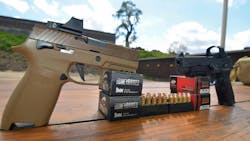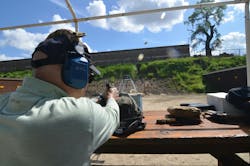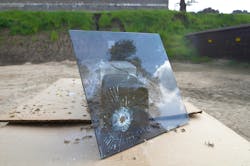Black Hills' HoneyBadger Ammo Aces the Test
I tested two of Black Hills Ammunition’s 9mm cartridges. If you are the kind of reader who looks at the article topic, and then scrolls down to look at the bottom line, here is your spoiler alert: When I completed this test, I emptied my primary magazine for my EDC 9mm and filled it with Black Hills HoneyBadger cartridges. I am carrying them right now. They are that good.
This article appeared in the May/June issue of OFFICER Magazine. Click Here to subscribe to OFFICER Magazine.
Black Hills Ammunition was started by Jeff Hoffman, a law enforcement officer for 37 years. In the industry, Black Hills Ammunition has built a reputation for consistency and innovation. Black Hills Ammunition is used by all branches of our military, adopted by many agencies, and many manufacturers use Black Hills for quality testing.
Ballistic gelatin
Testing cartridge performance is usually done with blocks of 10% gelatin, and various materials that one must shoot through. When I test cartridges, I look at their penetration into these blocks, consistency in performance, velocity, accuracy, reliability and other tertiary features, like the amount of flash when the cartridge is fired. If any of these factors fall short, the rest of the test is immaterial. For example, even if the cartridge performs superbly in gelatin, if it has no predictable accuracy, the cartridge is not useful.
I no longer use 10% gelatin to simulate living tissue. I use Clear Ballistics Gelatin, which is a more convenient alternative that gives reliable results. I have tested Clear Ballistics Gelatin against traditional gelatin blocks, and the results are similar enough for me to continue to use the “no mess” alternative. I can attest to this after 20 years of mixing gelatin blocks 20-50 pounds at the time in my garage, then clearing out racks on my refrigerator so that I could have them ready for range day the next day. That’s 20 years of, “You’re going to bring what into my house?”
Bullet design
Cartridge making is a compromise, which is part of the intrigue of cartridge making. For example, for a given bullet design, it is usually more desirable to have a higher velocity. For 9 mm, pushing a bullet to a higher velocity is usually the goal. However, if the cost of higher velocity is lower reliability, accuracy, or excessive pressure, it’s not worth it.
When it comes to service cartridges, the penetration standard has to fall between 12 and 18 inches for a cartridge to be considered effective. The FBI protocol uses a point scoring method, which awards higher points for penetration between 14-16 inches, and consistency from test cartridge to test cartridge. When I am doing similar tests, the one quality I prefer to have is consistency in the penetration when shooting through different media.
A good example is standard hollow point performance. I consider three of the testing protocols the most important for our purposes: bare gelatin, heavy clothing and auto glass. Some cartridges give a performance that is satisfactory, meaning between 12 and 18 inches, but they are all over the place. For example, some 9mm cartridges get the hollow point clogged in the heavy clothing test. When the bullet strikes the clothing layers, fibers get trapped inside the hollow point, essentially making it a solid-tip bullet. Because the bullets don’t open, they tend to over-penetrate. If they worked as advertised in bare gelatin, there is often a huge contrast in performance for the same cartridge.
The innovative response to the hollow point issue has been amazing. Hornady uses Flex Tip bullet technology, which consists of a soft tip inserted in the bullet. This tip controls the expansion, giving reliable performance in different media. Speer fills their premium hollow points with an elastomer compound, which delivers predictable performance in media.
The HoneyBadger approach is the most unique, and every product I have tested that has used this approach works. The bullets in the HoneyBadger line are not hollow points, nor are they made in the conventional way. Instead, they use physics to get the job done.
The HoneyBadger bullets are milled out of solid copper. They don’t resemble conventional bullets at all, except for the fact that they are cylindrical and they fit into the brass to make a loaded cartridge. Designed by Lehigh Defense, they look like a four-pointed star from the top, but do not look like truncated cones from the side. Instead, they look like the landing vehicle from a sci-fi fantasy, complete with scalloped wings and deep machined ridges.
When a bullet passes through tissue, its forward progress is impeded by the fluid in front of it. It stretches a cavity around it and in front of it. Because the expansion of a bullet and the wound channel cannot catch up with the shock, tearing and tissue damage occurs. An expanding hollow point causes more disruption because the lateral expansion increases the trauma. The desirable outcome is a wound channel that is much larger than the diameter of the bullet, coupled with the requisite expansion.
Conventional hollow point design maximizes trauma, prevents overpenetration, and rapidly transfers the energy of the bullet into the target.
The HoneyBadger bullet does not expand. In fact, when I drove it through bare gelatin and heavy material, the bullet looked like it could be loaded back into the cartridge and fired again. In barrier tests, it squished a little, but maintained 100% of its effectiveness.
The 100-grain HoneyBadger was supposed to average 1250 fps, according to Black Hills Ammunition. Out of my 3.8” barrel and across the screens, they averaged 1243 fps. This also came with a very low standard deviation, which indicates the consistency of the velocity.
The HoneyBadger bullet is 100 grains, which is much lighter than most duty rounds. Generally, the lighter the bullet, the lower the recoil, if other factors are similar. Since we did not gauge recoil, I can only share my shooting impression. It felt only slightly lighter. The cartridge was clean burning and cycled our guns flawlessly.
I had my associate, retired SRO Richard Macchia, shoot the HoneyBadger at 25 yards for accuracy. This meant I had to admit, in front of all my friends, that he is a better shooter. He shot from a rest, using his SIG P365. He had a “flier” in a couple groups, meaning he had a consistent group, except for a single round. Without the fliers, the groups were under 2” every time. Even with the fliers, the groups stayed under 3”. When I have tested cartridges in the past, most good performing cartridges averaged 2-3” at 25 yards. The Honey Badger was consistently more accurate.
I know that I said that the HoneyBadger is my new EDC cartridge. Here is why: The average of the penetration throughout the entire test was 17”. However, the difference amongst all of the tests was never more than 2”. That is, the bullets went 17.75” in bare gelatin, 17” in heavy clothing, and 16.5” after barrier. Few 9mm products give this kind of consistency.
124-grain +P HP
After evaluating the HoneyBadger, one would think that their 124-grain +P cartridge would be somewhat of a letdown. It wasn’t. In fact, it was on the pinnacle of the culmination of other brands of ammo I have tested before.
The 124-grain bullet is a truncated cone hollow point design, with skives to provide predictable expansion. Both the bullets and brass had a polished finish and the components had a certain lubricity. The design definitely would not be affected at all by variations in feed angles of different brands of guns.
Black Hills lists their 124-grain JHP +P as achieving 1200 FPS. Some manufacturers publish very optimistic numbers about their products, usually because they are fired through test barrels. When they are fired through duty guns, the numbers are often more honest. In my testing experience, Black Hills Ammunition does what is says it does. In this case, these cartridges averaged 1193 fps out of my 3.8” barrel M18. I ran quite a few bullets over the chronograph screens, and they performed flawlessly.
We shot the 124 grain into gelatin using a P365. It averaged 14.5” in bare gelatin, with 140% expansion. There was a huge temporary cavity in all of our tests. The round gave consistent performance all the way through.
Through the heavy clothing test, the Black Hills 124 grain +P sailed to 19”. The bullets delivered outstanding expansion, only later than tests in the bare gelatin.
The 124-grain bullet consistently stopped between 12-13” after the glass barrier, creating the same huge temporary cavities. There was a slight separation on one of the test bullets, but both core and jacket stayed together, with 140% expansion.
The 124-grain cartridges turned in consistent performance-respectable for any duty cartridge. If this was the choice for a cartridge contract for my agency, I would have been quite content. As you might have guessed, I picked the HoneyBadger between the two.
Reputation is everything in the cartridge industry. I could shoot Black Hills Ammunition all day (and I have). I know that the last shot is the same as the next shot, which is the same as the first shot. These products are ready to be sworn in for duty.
About the Author

Officer Lindsey Bertomen (ret.), Contributing Editor
Lindsey Bertomen is a retired police officer and retired military small arms trainer. He teaches criminal justice at Hartnell College in Salinas, California, where serves as a POST administrator and firearms instructor. He also teaches civilian firearms classes, enjoys fly fishing, martial arts, and mountain biking. His articles have appeared in print and online for over two decades.


